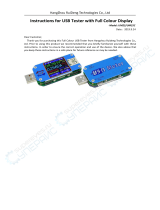目录
0.0 version and updates...............................................................5
1.0 Overiew...........................................................................5
2.0 pay attention to safety matters...................................................5
3.0 Performance description...........................................................6
3.0.1 Interface.....................................................................6
3.0.2 Human-computer interaction....................................................6
3.0.3 Voltage and current...........................................................6
3.0.4 Fast charge trigger...........................................................6
3.0.5 Wire identification...........................................................7
3.0.5 Miscellaneous.................................................................7
4.0 Appearance structure..............................................................7
5.0 Technical Specifications..........................................................8
6.0 Main Page.........................................................................9
6.0.1 Concise Page..................................................................9
6.0.2 Record page ................................................................10
6.0.3 Fast charge recognition page.................................................11
6.0.4 Curve display page...........................................................12
7.0 Expansion of recording function..................................................13
7.0.1 Energy Statistics List.......................................................13
7.0.2 Offline curve observation page...............................................14
8.0 Quick charge protocol trigger and detection menu.................................14
8.0.1 Automatic detection of fast charge protocol..................................15
8.0.2 QC2.0 trigger................................................................15
8.0.3 QC3.0 trigger................................................................16
8.0.4 Huawei FCP trigger..........................................................16
8.0.5 Huawei SCP trigger...........................................................16
8.0.6 Samsung AFC Trigger..........................................................17
8.0.7 PD protocol trigger..........................................................17
9.0 Charging tool....................................................................18
9.0.1 PD Listener..................................................................18
9.0.2 Read E-Marker cable..........................................................20
9.0.3 Wire resistance measurement page.............................................21
3






















